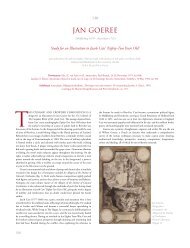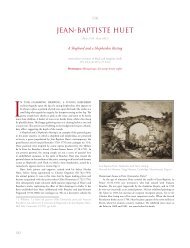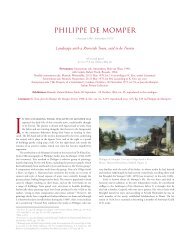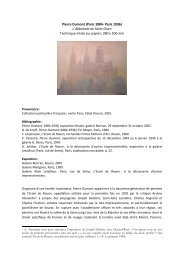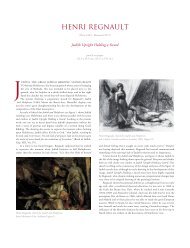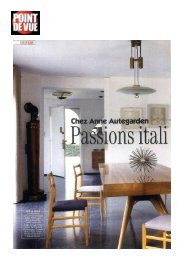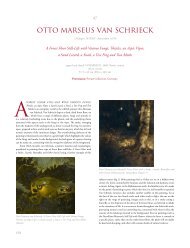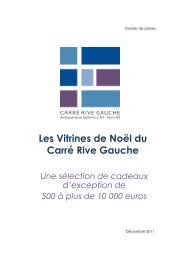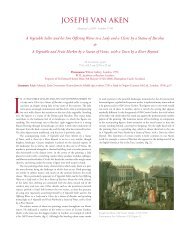aert van der neer, A River Landscape
aert van der neer, A River Landscape
aert van der neer, A River Landscape
Create successful ePaper yourself
Turn your PDF publications into a flip-book with our unique Google optimized e-Paper software.
In this dramatic and atmospheric painting, a<br />
solitary rowing boat makes its way downstream, away from the raging<br />
fire in the background. this blaze is the dominant feature of the<br />
painting, the bright whites and oranges illuminating the blackness<br />
of the night sky. rising up from the epicentre of the fire, where <strong>aert</strong><br />
<strong>van</strong> <strong>der</strong> <strong>neer</strong>’s colouring is at its most intense, the silhouette of the city’s<br />
cathedral spire is on the point of being engulfed by the flames. thick<br />
black smoke rises from the city and forms dense clouds which drift across<br />
the canvas. the depiction of the fire is <strong>van</strong> <strong>der</strong> <strong>neer</strong>’s focus in this work,<br />
rather than the surrounding landscape, and he delights in capturing the<br />
102<br />
21<br />
AERT VAN DER NEER<br />
(Amsterdam c.1603/04 - Amsterdam 1677)<br />
A <strong>River</strong> <strong>Landscape</strong> at Night with a Rowing Boat, a Burning City beyond<br />
signed with double monogram ‘aV n’ (lower left)<br />
oil on panel<br />
36.8 x 45.1 cm (14½ x 17¾ in)<br />
Provenance: anonymous sale, charles sedelmeyer, paris, 25 may, 1907, lot 144;<br />
with Leonard Koetser, London;<br />
from whom purchased by h. dormond, 21 January, 1970;<br />
swiss private collection.<br />
Exhibitions: London, Leonard Koetser gallery, autumn 1969, no. 2.<br />
Literature: c. hofstede de groot, A Catalogue Raisonné of the Works of the Most Eminent Dutch Painters (London, 1923), p.475;<br />
W. stechow, Dutch <strong>Landscape</strong> Painting of the Seventeenth Century (London, 1968), p.181;<br />
exhibition catalogue, autumn 1969, Leonard Koetser gallery, no. 2, illustrated;<br />
W. schulz, Aert <strong>van</strong> <strong>der</strong> Neer, doornspijk, 2002, p. 473, no. 1424, pl. 315.<br />
<strong>aert</strong> <strong>van</strong> <strong>der</strong> <strong>neer</strong>, A <strong>River</strong> <strong>Landscape</strong> at Night with a Rowing Boat, a<br />
Burning City beyond (detail)<br />
<strong>aert</strong> <strong>van</strong> <strong>der</strong> <strong>neer</strong>, Burning Castle before a City, after 1650,<br />
private collection (Figure 1)<br />
subtle variation in the flames and smoke. the colours of the fire are<br />
reflected on the still river which runs back into the picture, drawing<br />
the eye towards the blaze. on the banks of the river other figures stand<br />
about by the boats watching the spectacular sight from a safe distance.<br />
in contrast to the frenzy of the burning city, there is a sense of stillness<br />
and quiet about the foreground scene. it seems almost disconnected from<br />
events in the background, an effect emphasised by the isolation of the<br />
figures, alone on the river.<br />
Van <strong>der</strong> <strong>neer</strong> depicted burning cities on a number of occasions,<br />
another example being Burning Castle before a City (fig. 1). once more,<br />
a river is used to lead the eye back into the composition where a city
Jan Beerstraten, The Fire of the Old Town Hall on the Dam, 7 July 1652,<br />
c.1652-1655, amsterdams historisch museum, amsterdam (Figure 2)<br />
is ablaze in the background. as in the present work, the monumental<br />
buildings are not depicted in detail, but their dark shapes are silhouetted<br />
against the intense colour of the flames. the way in which buildings can<br />
be picked out from the darkness reveals <strong>van</strong> <strong>der</strong> <strong>neer</strong>’s fascination for<br />
using a single light source to illuminate his paintings, and examining how<br />
this source affects the surrounding landscape. the low view point and flat<br />
nature of the landscape in both works allows a greater proportion of the<br />
canvas to be given over to the depiction of the sky, across which <strong>van</strong> <strong>der</strong><br />
<strong>neer</strong> has skilfully depicted the thick black clouds of suffocating smoke.<br />
in both works, <strong>van</strong> <strong>der</strong> <strong>neer</strong> has included figures in the foreground which<br />
serve to humanise the spectacular scene; but these figures are cast in deep<br />
shadow and do not detract from the vision of the burning city.<br />
the depiction of fire was certainly a popular subject during the<br />
seventeenth century. in part this may have been because many artists<br />
witnessed a particularly noteworthy one in 1652. the city authorities<br />
of amsterdam had decided to replace their old town hall with proceeds<br />
from the city’s growing prosperity and wealth. in 1638, caspar <strong>van</strong><br />
Baerle (1584-1648) had written of the building, ‘its antiquity and<br />
<strong>aert</strong> <strong>van</strong> <strong>der</strong> <strong>neer</strong>, Night <strong>Landscape</strong> with a <strong>River</strong>, mid-17th century,<br />
The hermitage, st. petersburg; Via the state museum Fund from the<br />
shuvalov collection, st. petersburg, 1919 (Figure 3)<br />
104<br />
<strong>aert</strong> <strong>van</strong> <strong>der</strong> <strong>neer</strong>, A <strong>River</strong> <strong>Landscape</strong> at Night with a Rowing Boat, a<br />
Burning City beyond (detail)<br />
dilapidation lend the building a certain venerableness. a city which<br />
is otherwise so splendidly built shows how simple she was of old’.¹<br />
however, it was felt that the ramshackle old building should be replaced.<br />
Yet before it had been demolished it was destroyed by a devastating<br />
blaze, taking with it many historical documents and other treasures. the<br />
city was rife with rumours of arson, guards were deployed to prevent<br />
looting and there was a real sense of significance attached to the event.<br />
the momentous fire was depicted by a number of artists, including<br />
rembrandt <strong>van</strong> rijn (1606-1669) and Jan Beerstraten (1622-1666)<br />
(see inventory). Beerstraten’s The Fire of the Old Town Hall on the Dam,<br />
7 July 1652, see figure 2, is in many ways a very different picture to A<br />
<strong>River</strong> <strong>Landscape</strong> at Night with a Rowing Boat, a Burning City beyond,<br />
but both works share the central concern for capturing how a powerful<br />
blaze can illuminate the nocturnal darkness. Both artists seem to have<br />
revelled in the challenge of depicting this unusual and powerful sight;<br />
the juxtaposition of brightness against the deep shadows. although<br />
The Fire of the Old Town Hall on the Dam, 7 July 1652 is more of a<br />
documentary work than <strong>van</strong> <strong>der</strong> <strong>neer</strong>’s fiery landscapes, both works<br />
demonstrate the artists’ technical virtuosity in capturing these unusual<br />
atmospheric effects.<br />
Van <strong>der</strong> <strong>neer</strong> rarely depicted landscapes during daylight hours,<br />
preferring instead to paint slightly unusual light effects. For this<br />
reason, nocturnes such as A <strong>River</strong> <strong>Landscape</strong> at Night with a Rowing<br />
Boat, a Burning City beyond, feature prominently in his work, although<br />
rather than the drama of a fire, these landscapes are often illuminated<br />
by the piercing light of the moon. an especially fine example is the<br />
hermitage’s Night <strong>Landscape</strong> with a <strong>River</strong> (fig. 3). as in the present<br />
work, the painting is illuminated by a single light source in the distance.<br />
For this reason the sky in the background is brightly lit, the colours rich<br />
and deep, whereas the foreground is comparatively dark and shadowed.<br />
once more, <strong>van</strong> <strong>der</strong> <strong>neer</strong>’s compositional skill is evident as he leads<br />
the eye through the scene, although here the thick bank of trees on the<br />
left-hand side is used, as opposed to the strong recessional line of the<br />
river in the present work. the rustic setting is of course far removed<br />
from the urban waterway depicted in A <strong>River</strong> <strong>Landscape</strong> at Night with a<br />
Rowing Boat, a Burning City beyond but it is noticeable how the play of<br />
light on relatively still water is a central concern in both works. in the<br />
¹ Van Baerle, c., ‘medicea hospes’ (1638), trans. in schwartz, g., The Dutch<br />
World of Painting, exh. cat. (The Vancouver art gallery and the rijksdienst<br />
Beeldende Kunst, 1986), cat. no. 16.
<strong>aert</strong> <strong>van</strong> <strong>der</strong> <strong>neer</strong>, <strong>Landscape</strong> with a Windmill, c.1646,<br />
The hermitage, st. petersburg; duval collection, st. petersburg, 1805<br />
(Figure 4)<br />
hermitage’s work the light is actually refracted to a much greater extent<br />
in the sky, where the rippling undulations of the clouds are picked out<br />
in exquisite detail by <strong>van</strong> <strong>der</strong> <strong>neer</strong>. the sense of quiet that pervades the<br />
foreground of the present work has already been discussed and a similar<br />
sense of tranquillity can be found in Night <strong>Landscape</strong> with a <strong>River</strong>, with<br />
its statuesque cattle and dark forbidding forest.<br />
the light effects in <strong>van</strong> <strong>der</strong> <strong>neer</strong>’s work are not always as intense<br />
as in the previous paintings but they are invariably interesting, an<br />
example being the hermitage’s <strong>Landscape</strong> with a Windmill (fig. 4). in this<br />
work the sun appears to be rising and a few figures can already be seen<br />
scattered throughout the work. the soft pink light comes from the righthand<br />
side of the work but is not consistent throughout the work, rather<br />
there is a sense of the light slowly flowing across the scene, warming the<br />
landscape as it rises into the sky. Van <strong>der</strong> <strong>neer</strong> has beautifully captured<br />
the ephemeral nature of the dawn light, just as he captures the variety of<br />
colour and movement of the fire in the present work. it is also noticeable<br />
how certain compositional tricks recur throughout his work, for example<br />
foreground and background are united by the echo of the windmill, just<br />
as the church spire is echoed in A <strong>River</strong> <strong>Landscape</strong> at Night with a Rowing<br />
Boat, a Burning City beyond.<br />
according to the biographer arnold houbraken (1660-1719), as a<br />
youth <strong>van</strong> <strong>der</strong> <strong>neer</strong> lived in a small town, east of dordrecht, working as<br />
<strong>aert</strong> <strong>van</strong> de <strong>neer</strong>, A <strong>River</strong> in Winter, c.1645,<br />
The hermitage, st. petersburg; acquired at the sale of the cardinal<br />
Valenti collection, amsterdam, 1763 (Figure 5)<br />
a major, or steward for the lords of arkel and in these early years he was<br />
only an amateur painter. he came into contact with the camphuyzen<br />
brothers, rafael (1597/8-1657) and Jochem (1601/2-59) and married<br />
their sister. this friendship probably helped to ad<strong>van</strong>ce his career and<br />
his early work certainly bears their influence. By the 1640s he had a<br />
firmly established style and a relatively narrow range of subject matter,<br />
specialising in sunrises, sunsets, nocturnes, especially moonlit river<br />
scenes, and winter scenes such as the hermitage’s <strong>River</strong> in Winter (fig.<br />
5). as we have seen, several characteristic features recur throughout<br />
his work, most notably the receding waterways, across which the light<br />
invariably plays. small, slightly indistinct figures or cattle of often serve<br />
to animate the foreground and middle distance and there is often the<br />
silhouette of a town in the distance.<br />
it is, however, due to ‘his sensitivity to coloured light and<br />
atmosphere’ that <strong>van</strong> <strong>der</strong> <strong>neer</strong> ‘is celebrated as one of the greatest<br />
dutch landscapists’.² his art is characterised by the subtlety and skill<br />
of his tonal changes in the depiction of light as it is affected by thick<br />
cloud or encroaching darkness. Walther Bernt states that <strong>van</strong> <strong>der</strong> <strong>neer</strong>’s<br />
landscapes are ‘distinguished by a poetic feeling for nature and by their<br />
successful treatment of the problem of light...he is an unequalled<br />
observer of light effects and reflection on land and water, of cloud<br />
shapes by night or in a wintry sky’.³<br />
<strong>aert</strong> <strong>van</strong> <strong>der</strong> <strong>neer</strong>, A Canalside in Holland,<br />
The Louvre, paris (Figure 6)<br />
Van <strong>der</strong> <strong>neer</strong>’s painting reveals a number of influences. his winter<br />
scenes, such as <strong>River</strong> in Winter, displays the same ability to capture<br />
atmosphere as in the present work. these scenes are much more<br />
populated than his other landscapes and these figures and the frozen<br />
river recall the Flemish traditions that are also evident in the bank of<br />
large gnarled trees in Night <strong>Landscape</strong> with a <strong>River</strong>. he also seems to<br />
have been friends with aelbert cuyp (1620-1691) and they sometimes<br />
worked on the same canvases. an example of this collaboration is the<br />
Louvre’s A Canalside in Holland where it seems cuyp depicted the<br />
staffage in the foreground and yet the painting retains the tranquil<br />
beauty that is evident in <strong>van</strong> <strong>der</strong> <strong>neer</strong>’s work (fig. 6). Van <strong>der</strong> <strong>neer</strong><br />
was also influenced by the ‘tonal’ phase of dutch landscape painting,<br />
embodied by the work of Jan <strong>van</strong> goyen (1596-1656) (cat. no. 89) and<br />
salomon <strong>van</strong> ruysdael (1600/03-1670) (cat. nos. 90 & 91), evident in<br />
the atmospheric tonalities of his work.⁴<br />
² sutton, p. c., Dutch & Flemish Paintings; The Collection of Willem Baron <strong>van</strong><br />
Dedem (Frances Lincoln Ltd., 2002), p. 175.<br />
³ Bernt, W., The Netherlandish Painters of the Seventeenth Century, vol. ii<br />
(phaidon, London, 1970), p. 85.<br />
105



